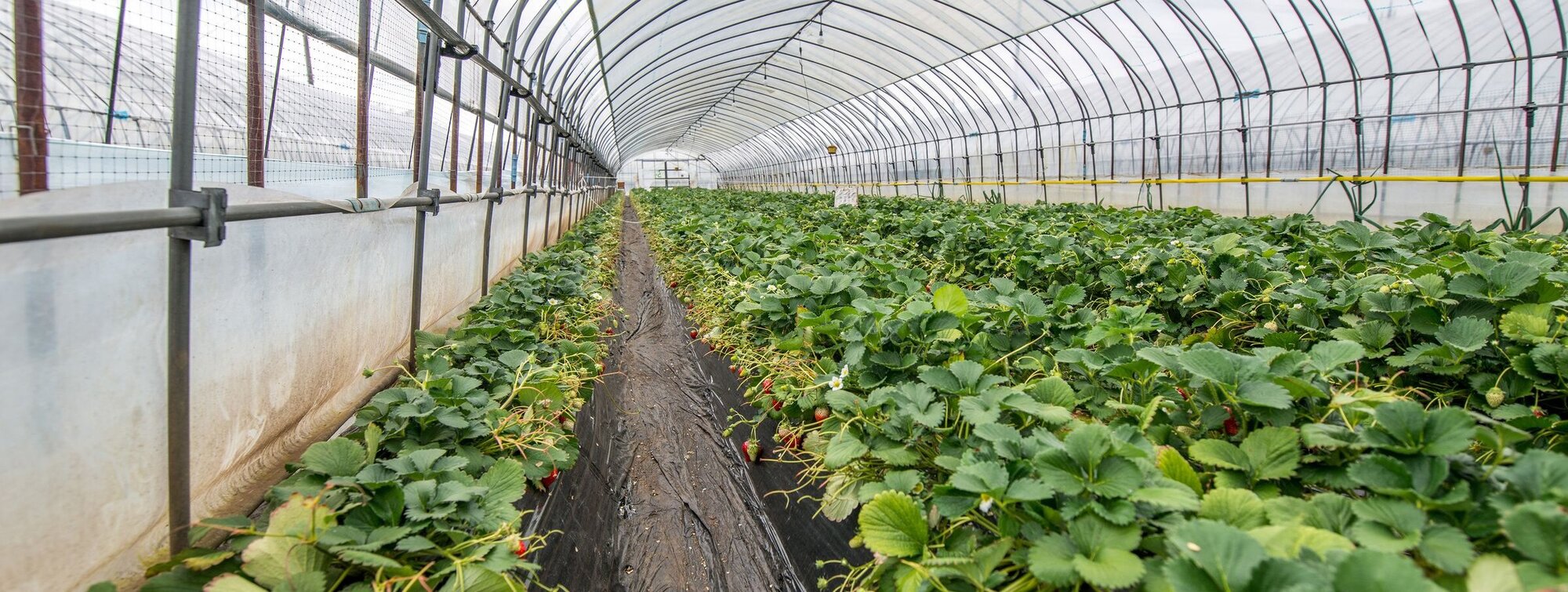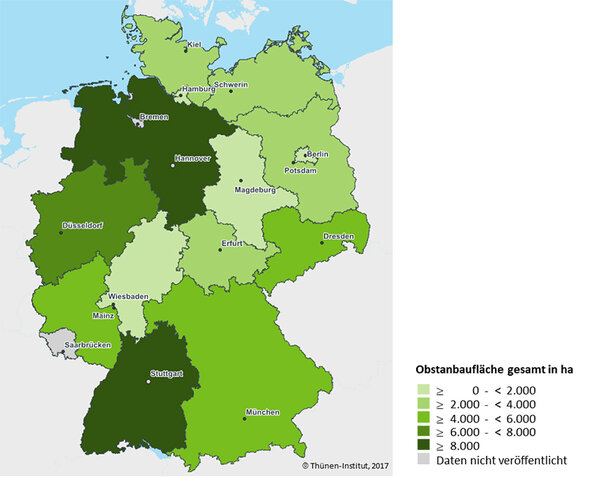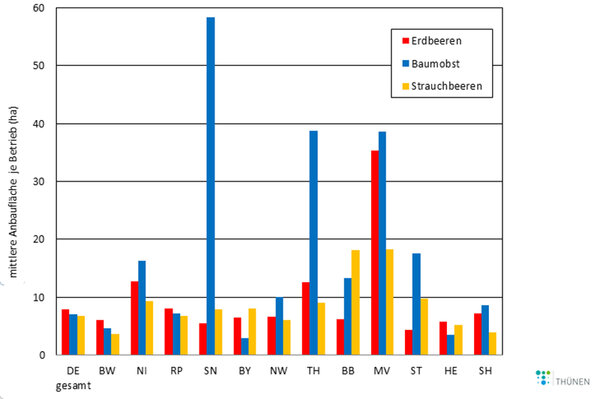Facts & Figures
Cultivated areas for soft fruit and protected fruit growing are steadily increasing
Walter Dirksmeyer und Hildegard Garming | 17.06.2022
The analysis of 2018 shows: Fruits are produced in all federal states. There are, however, significant regional differences. For example, Baden-Württemberg ranks first among the German states with more than 23,000 hectares of fruit cultivation, followed by Lower Saxony with around 15,000 hectares and North Rhine-Westphalia with 6,100 hectares (Map 1).
In addition, depending on the type of fruit, there are smaller regional cultivation focuses, such as stone fruit cultivation in the counties of Mainz-Bingen, Mainz and Mayen-Koblenz in Rhineland-Palatinate, apple cultivation in the Saxon county of Sächsische Schweiz-Osterzgebirge, sweet cherries in Upper Franconia and black currants in Lower Franconia in Bavaria.
The area under tree fruit has changed little over the past ten years. With about 68% of the tree fruit area, apples are in first place, followed by sweet cherries, which occupy about 12% of the tree fruit area with about 6,000 hectares. Sour cherry cultivation has been affected by a significant decline. Between 2007 and 2017, the area under sour cherry declined by 43% to of 1,950 hectares.
There has been a significant increase in bush berry acreage. Since 2012, detailed data have been available annually in the bush berry survey. Between 2012 and 2018, the total area under cultivation increased by 41%. This is primarily due to an increase in blueberry acreage, but the total acreage of buckthorn, chokeberry, gooseberry, blackberry, and elderberry has also increased (Graph 1). About a quarter of bush berry acreage is on farms with organic production.
The farm structures show a typical distribution of farm sizes between the German states (graph 2). In southern Germany, average size of fruit-growing farms is much smaller than in northern and eastern Germany. The largest average cultivated areas per farm are found in Thuringia, Saxony and Brandenburg.
However, the average acreage of tree fruit per farm in the eastern states decreased between 2012 and 2017. In terms of fruit types, the average cultivation area per farm is largest for strawberries with 7.9 hectares, followed by bush berries with 6.8 hectares and tree fruit with 7 hectares.
The variation between the German states is enormous. Saxony leads the way in tree fruit cultivation with an average of 58 hectares per farm, Mecklenburg-Western Pomerania with around 18 hectares in bush berry cultivation and Schleswig-Holstein with around 13 hectares of average cultivation area per farm for strawberries.
The distribution of cultivated areas according to size classes shows that for all fruit crops a large proportion of the cultivated area is located on farms with more than 10 hectares. The development of farm structures during the past 15 years shows that the structural change in fruit growing is ongoing: The number of farms is decreasing, especially in the lower size classes, while the average cultivated area per farm is steadily increasing (Table 1).
Table 1: Number of farms and cultivated areas of tree fruit by German states in 2007, 2010 and 2017. Data source: Federal Statistical Office
Year | 2007 | 2012 | 2017 | |||
|---|---|---|---|---|---|---|
cultivated areas and farms | ha | Number of farms | ha | Number of farms | ha | Number of farms |
Gemany | 46.893 | 8.688 | 45.593 | 7.455 | 49.934 | 7.167 |
Baden-Württemberg | 14.479 | 4.575 | 14.820 | 4.021 | 18.310 | 4.003 |
Niedersachsen | 8.906 | 720 | 9.257 | 650 | 9.173 | 566 |
Rheinland-Pfalz | 4.198 | 904 | 3.679 | 684 | 3.990 | 555 |
Sachsen | 4.102 | 72 | 3.440 | 54 | 3.382 | 58 |
Bayern | 2.688 | 1.395 | 2.435 | 1.029 | 2.824 | 957 |
Nordrhein-Westfalen | 2.238 | 271 | 2.207 | 269 | 2.727 | 272 |
Thüringen | 2.434 | 57 | 2.022 | 50 | 1.706 | 44 |
Brandenburg | 2.227 | 126 | 1.976 | 116 | 1.545 | 116 |
Mecklenburg-Vorpommern | 1.499 | 28 | 1.619 | 35 | 1.930 | 50 |
Sachsen-Anhalt | 1.687 | 91 | 1.557 | 84 | 1.103 | 63 |
Hamburg | 1.095 | 120 | 1.197 | 111 | 1.483 | 105 |
Hessen | 561 | 209 | 667 | 244 | 975 | 279 |
Schleswig-Holstein | 695 | 109 | 573 | 86 | 628 | 73 |
Download Service
- Thünen Working Paper 100Entwicklungen des Obstbaus in Deutschland von 2005 bis 2017: Obstarten, Anbauregionen, Betriebsstrukturen und Handel (in German)










